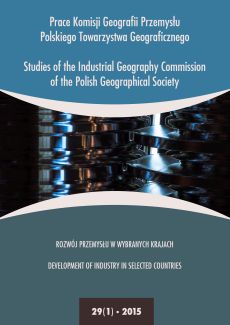Spatial aspects of the production and export of buses in Poland in the years 1989–2014
DOI:
https://doi.org/10.24917/20801653.291.4Keywords:
bus export, transnational corporations, bus production, transformation of the automotive industryAbstract
In Central and Eastern Europe in the years 1949-1991 there existed the Council for Mutual Economic Assistance, which brought together the socialist countries of this part of the world. The internal rules of the organization selected leading companies in the production of rolling stock for public transport. Among many facilities producing buses, trams and trolleybuses, most supplied local markets only (within country borders where the facility was located), only a few were much more financed and developed, and they were engaged in the provision of rolling stock on a larger scale - export occurred (but mainly between the Council’s members). After a period of political change associated with the change of the government system, changes in Central and Eastern Europe started a significant transformation of the automotive industry, including the production of public transport fleet. In Poland, before 1989 there were two bus factories (in Sanok - “Autosan” and in Jelcz-Laskowice - “Jelcz”). After the political transformation, the market of the rolling stock producers in Poland has undergone a tremendous transformation. The main factors of the change were relatively low production costs (mainly due to lower wages than the ones of the workers in Germany) while maintaining quality and timeliness. These determinants influenced the decision on the transfer of production by large corporations to the countries of Central and Eastern Europe, including Poland. The second factor of this transformation was the privatization process in Polish factories and the technology transfer related to the process. Another important element was the investment of private capital in the production of transport vehicles, which has resulted in creating new production sites. Over the last 25 years Poland has become one of the major bus manufacturers in Europe. During this period, foreign brands opened new factories and Polish companies began producing vehicles under new brands. Companies in Jelcz- Laskowice and Sanok underwent the privatization process. The article analyses the transformation of the bus manufacturers market in Poland, both in terms of location and volume of production for the past 25 years. It also shows the export volume in spatial terms for the analyzed period of 1989-2014. Moreover, it defines factors for success and failure in the production and export of buses among existing producers.
Downloads
Metrics
References
Ambukita, E. (2013). Bezpośrednie inwestycje zagraniczne w województwie wielkopolskim. Prace Naukowe Uniwersytetu Ekonomicznego we Wrocławiu, 315, 33–42.
Czapliński, P., Stawarska, A. (2010). Przejawy procesu globalizacji w sferze produkcji na przykładzie Scania Production Słupsk S.A. Prace Komisji Geografii Przemysłu Polskiego Towarzystwa Geograficznego, 16, 176–186.
Ćwikła, M. (2014). Przemiany strukturalne w produkcji autobusów w Polsce. Prace Komisji Geografii Przemysłu Polskiego Towarzystwa Geograficznego, 27, 164–180.
Domański, B., Guzik, R., Gwosdz, K., Dej, M. (2013). The crisis and beyond: the dynamics and restructuring of automotive industry in Poland. Int. J. Automotive Technology and Management, 2 (13), 151–166.
Dyr, T. (2009). Solaris na europejskim rynku autobusowym. Autobusy: Technika, Eksploatacja, Systemy Transportowe, 3, 14–20. European Automobile Manufacturers Association (2014, 27 listopada). Pozyskano z http://www.acea.be
Gierańczyk, W. (2003). Wybrane aspekty konkurencyjności polskiego przemysłu w dobie globalnych wyzwań. Prace Komisji Geografii Przemysłu Polskiego Towarzystwa Geograficznego, 6, 77–86.
Gwosdz, K., Guzik, R., Domański, B. (2011). Environmental pressure in fragmented markets: the fall and rise of bus makers in Poland. European Review of Industrial Economics and Policy, 3. Pozyskano z http://revel.unice.fr/eriep/index.html?id=3317.
Infobus (2014, 20 listopada). Pozyskano z http://www.infobus.com.pl.
JMK Analizy Rynku Transportowego za lata 1998–2014, materiały niepublikowane.
Kierecki, A. (2000). Zmiany na polskim rynku autobusowym w latach 1999–2000. Autobusy: Technika, Eksploatacja, Systemy Transportowe, 11, 26–32.
Kierecki, A. (2003). Kapena i Irisbus razem na rynku polskim. Autobusy: Technika, Eksploatacja, Systemy Transportowe, 7–8, 23–24.
Klukowski, A., Rusak, Z. (2007). CMS Auto – komfort w każdym wymiarze. Autobusy: Technika, Eksploatacja, Systemy Transportowe, 7–8, 42–45.
Lizak, P. (2009). Kształtowanie się przemysłu samochodów osobowych w krajach Europy Środkowej w latach 1997–2007. Prace Komisji Geografii Przemysłu Polskiego Towarzystwa Geograficznego, 14, 50–56.
Pawlak, G. (2011). Tradycja i nowoczesność: sto lat autobusów Scania. Autobusy: Technika, Eksploatacja, Systemy Transportowe, 9, 10–16.
Połom, M., Turżański, B. (2011). Doświadczenia Solaris Bus & Coach w produkcji trolejbusów. TTS Technika Transportu Szynowego, 4, 42–49.
Połom, M., Turżański, B. (2015). Produkcja i sprzedaż trolejbusów Solaris Trollino w latach 2011– 2014. Autobusy: Technika, Eksploatacja, Systemy Transportowe, 4, 8–12.
Rusak, Z. (2000). Producenci na rynku autobusowym w Polsce. Autobusy: Technika, Eksploatacja, Systemy Transportowe, 1–2, 16–24.
Rusak, Z. (2002). Polskie zakłady MAN-a istotnym elementem nowej strategii MAN Bus GmbH. Autobusy: Technika, Eksploatacja, Systemy Transportowe, 7–8, 60–63.
Rusak, Z. (2008). Producenci na rynku autobusów w Polsce. Autobusy: Technika, Eksploatacja, Systemy Transportowe, 1–2, 34–41.
Rusak, Z. (2009). Pięciotysięczny autobus z Bolechowa. Autobusy: Technika, Eksploatacja, Systemy Transportowe, 5, 6–14.
Rusak, Z. (2010). Zwiększenie mocy produkcyjnych w Scania Production Słupsk. Autobusy: Technika, Eksploatacja, Systemy Transportowe. 6, 18–22.
Rutka, G. (2008). Autobusy z Sulejówka. Trailer, 12, 36–37.
Sala, S. (2006). Polskie firmy na tle zagranicznych korporacji w dobie globalizacji. Prace Komisji Geografii Przemysłu Polskiego Towarzystwa Geograficznego, 9, 170–180.
Stefaniak, P. (2001). Autosan S.A.: Sylwetka firmy. Boss–Gospodarka, 35, 23–24.
Wieloński, A. (2009). Polska regionalnym centrum europejskiego przemysłu motoryzacyjnego. Prace i Studia Geograficzne, 42, 187–200.
Wieloński, A. (2010). Wielkość i struktura eksportu miarą konkurencyjności polskiego przemysłu. Prace Komisji Geografii Przemysłu Polskiego Towarzystwa Geograficznego, 15, 99–104.
Wolszczak, K. (2005). Nowości Solbusa. Autobusy: Technika, Eksploatacja, Systemy Transportowe, 7–8, 50–51.
Wołoszyn, R. (2012). Dwunastometrowy Solaris Urbino electric: dopełnienie oferty. Autobusy: Technika, Eksploatacja, Systemy Transportowe, 10, 10–14.
Downloads
Published
How to Cite
Issue
Section
License
Articles are published under the terms of the Creative Commons License (CC BY-ND 4.0; Attribution– NoDerivs).

